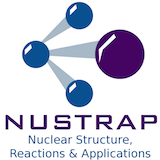The cornestones of contemporary Nuclear Physics are the investigation
of structure, the dynamics between protons and neutrons, and the
understanding of the quantum nucleonic interplay.
Nuclear Structure is a rather wide field of study ranging from
experimental investigations of nuclear observables to theoretical
interpretations of the experimentally observed phenomena. Nuclear
masses, level energies, cross sections, E/M moments, lifetimes and
several other important quantities are studied in an attempt to
answer fundamental questions lying at the center of nuclear physics:
what is the nature of the nuclear forces, especially at the edge of
the nuclear chart and in extreme environments such as cosmic events
and supernovas?
The NuSTRAP activities regarding nuclear structure deal with
experimental measurements of structural properties, such as the
nuclear shape, the lifetimes or the E/M moments. Special emphasis is
given on the utilization of radioactive beams that have been
recently introduced as an important tool for nuclear physics
experiments. The experiments are carried out at several large
facilities around the world capable of producing these beams at high
energies and intensities (GANIL, GSI, CERN/ISOLDE, Jyväskylä
etc). These experiments aim at measuring properties of very rare,
exotic species that are non-approachable by the older generation
accelerators.
The outcome of the experiments offer invaluable information on the
proton-neutron interplay which in turn offers a deep insight on the
behavior of the strong nuclear interaction at extreme states of
matter.
The NuSTRAP group is quite active in experiments with RIB with
special emphasis on lifetimes and E/M moments. Our published work
has appeared in high impact factor journals and international
conference proceedings volumes.
